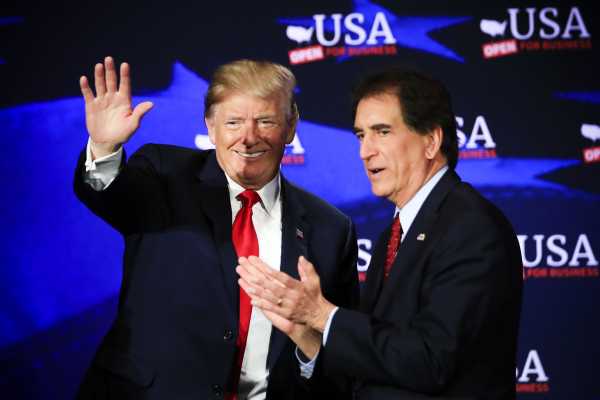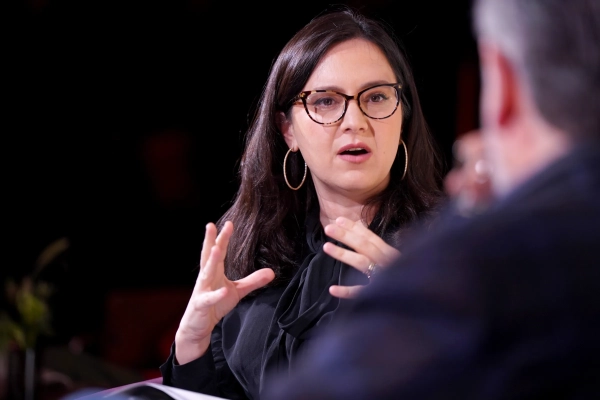
Rep. Jim Renacci won the Ohio Republican Senate nomination on Tuesday, setting up a showdown with Democratic Sen. Sherrod Brown in November.
Renacci bested Cleveland banker Mike Gibbons and several other lower-profile candidates to claim the nomination. He was considered the frontrunner, having received an endorsement from President Trump in recent weeks.
Ohio swung dramatically toward Republicans in 2016: After President Obama won the state by 3 percentage points in 2012, Trump beat Hillary Clinton there by eight points. Brown is currently the only Democrat holding statewide elected office in the Buckeye state.
The two-term senator, who was first elected to the Senate in 2006, remains popular in Ohio and might have the right kind of populist persona to play well in the state. Brown is still considered a slight favorite to win this November: The UVA Crystal Ball rates the race “Lean Democrat,” as does the Cook Political Report. A Ohio Republican recently told me Brown is expected to win by eight to 10 points.
Nevertheless, the race will be watched closely, as a test of whether Democrats can regain some ground in the Buckeye State — and if Democrats are to have any hope of taking over the Senate next year, Brown needs to keep his seat.
Who is Jim Renacci?
Renacci has served in a district covering northeastern Ohio since 2011. He is explicitly tying himself to Trump. He said the White House called him shortly before he jumped into the Senate, urging him to run. He is already noting that he endorsed Trump over Ohio Gov. John Kasich during the 2016 Republican presidential primary.
“The president knows that I’ve supported his agenda from then all the way through today,” he said recently on Fox News. ”The president wants to help me with this race.”
He faced an early test in that same interview, the day after Trump called African nations “shithole” countries during an immigration meeting with a bipartisan group of senators. Renacci found a way to explain away the president’s comments in a preview of the race he is likely to run.
“I’ve said all along, the president says what many people are thinking. … That’s a business guy going into a political career. It’s difficult. I know it’s difficult for the president,” he said. “Judge the president after four years, after what we’ve done. Let’s not judge the president by what he says.”
Renacci has also faced questions since he became the presumptive GOP frontrunner about some political contributions that he made as a registered lobbyist. But he still has Trump’s backing.
Why Sherrod Brown has to be considered the favorite in Ohio
The biggest thing Brown has going for him is Trump.
The backlash against the party currently occupying the White House is one of the bedrocks of American politics. It (almost) always happens. Democrats are already starting midterms (in theory) with an advantage.
Helping matters for Brown is Trump’s deep unpopularity nationwide and his relative unpopularity in Brown’s state (this October post by FiveThirtyEight compiling state approval ratings had Trump five points underwater in Ohio).
“It may sound overly simplistic, but Trump being in the White House is the biggest reason why Brown is favored,” Kyle Kondik at the University of Virginia’s Center for Politics, who wrote a book on Ohio politics, told me recently. “There’s just a frequent midterm drag that hurts the presidential party and helps the non-presidential one, and that’s exacerbated when the president is unpopular.”
Kondik pointed to data that show Senate incumbents in the out-of-power party have won reelection 91 percent of the time since 1914, when popular elections for Senate seats began.
On the other hand, Ohio presents some natural challenges for Brown, even in the favorable national environment. The Ohio Democratic Party has struggled to build a bench in recent years, with Republicans still favored in the governor’s race despite the national headwinds. The midterm electorate is usually older and whiter — and Trump won big here. A Democrat can’t simply coast to victory in Ohio on an anti-Trump wave.
In the eyes of Ohio Democrats, the 2016 election offered two lessons: First, yes, you have to turn out the Democratic base. But you also have to win over some number of independent voters or Republican-leaning voters, people who voted for Barack Obama in 2012 and Donald Trump in 2016. That is just Ohio’s makeup now.
“Sherrod wins here because Ohioans know that he works hard, he cares about them, and he approaches every issue carefully, intelligently, and with an eye on what’s best for working families. That’s more important to Ohioans than any partisan loyalty,” Justin Barasky, Brown’s campaign manager, said. “He’s got an ability to appeal to voters of all stripes, even a Republican who voted for Trump and may disagree with him on health care because they see him fighting against bad trade deals that have cost our state jobs.”
Brown is the kind of Democrat who could still play well with an electorate that is otherwise turning Trump-y. He is seen as populist, with a blue-collar tinge despite his Yale bachelor’s degree. He has real credibility with the progressive grassroots.
“In terms of his record, progressives nationally and in Ohio have always respected Senator Brown. He usually says and does what he thinks is right,” one operative at a leading grassroots group told me earlier this year. “Unlike Donald Trump, Senator Brown is a real populist. He has a record of speaking out against the big banks and Wall Street when it matters.”
Sourse: vox.com






